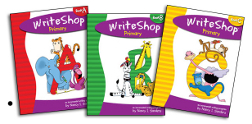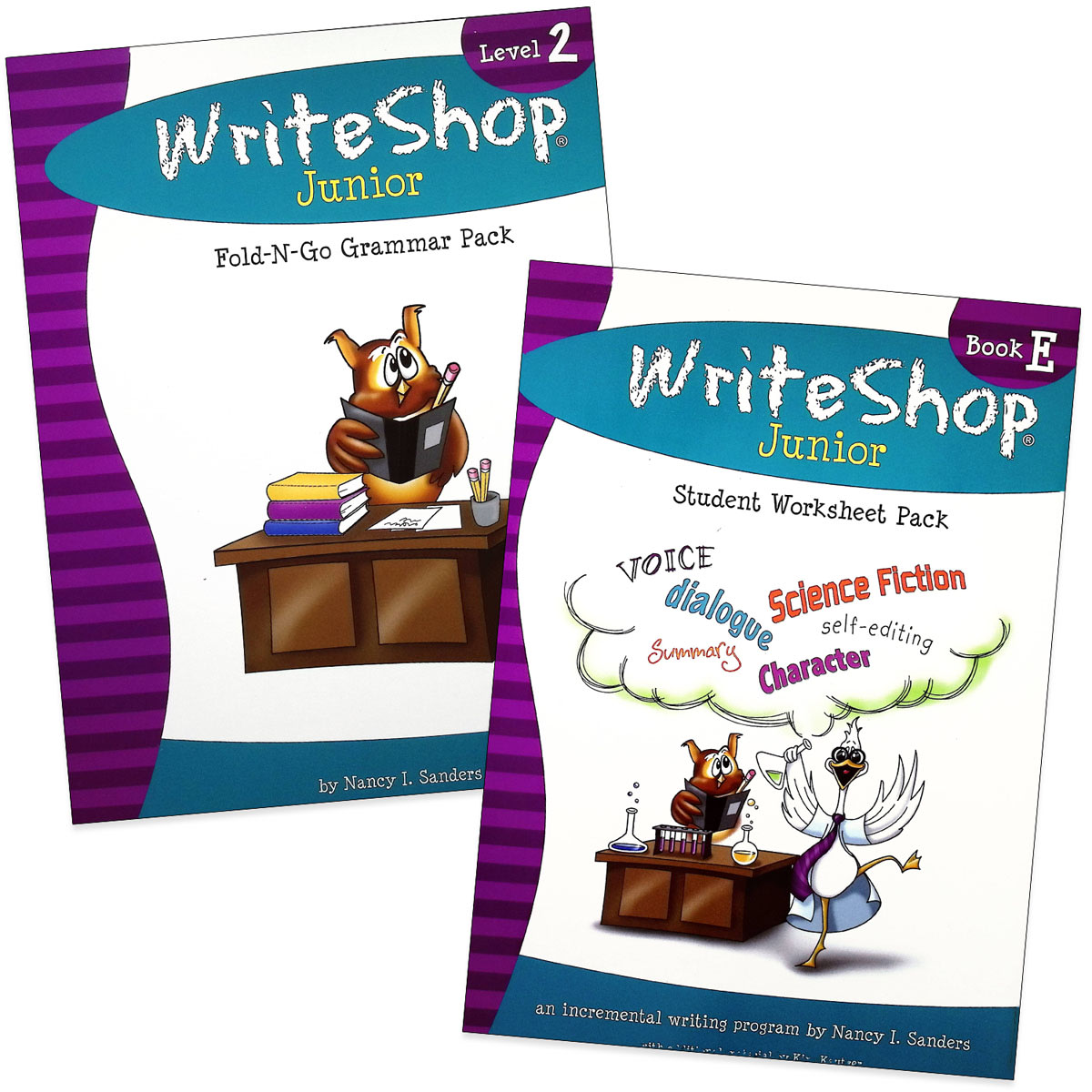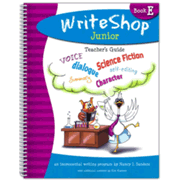WriteShop Primary, designed for grades K-3, and WriteShop Junior for grades three through six were written by a different author than the original WriteShop courses for the upper grades. They have many of the same elements that make both programs good choices for homeschoolers. Thorough, step-by-step lesson plans make it easy for even the novice parent/teacher to teach. Lessons are designed to be very interactive and multi-sensory.
WriteShop Primary consists of Books A through C while WriteShop Junior has Books D through F. There are ten lessons per book with suggested lesson schedules for one, two, or three weeks per lesson. Most families choose the latter, completing each book in 30 weeks (one school year).
Following the chosen schedule, children work through a sequence of eight activity sets to complete a writing project for each lesson. The activity sets lead the child through the steps of the writing process from prewriting through brainstorming, writing a first draft, editing and revising, and creating a final draft.
While WriteShop Primary and Junior can be used in a classroom with multiple students, they also work well in a one-on-one situation since most lessons flow from the child's comments and responses.
There is a Teacher's Guide course book and an Activity Pack for each level. While each course has a targeted grade-level range, there is flexibility for overlap. In addition, each course can stand on its own so you can jump in at any level.
The great thing about WriteShop courses is that lessons gradually work through the steps in the writing process, making the process enjoyable and student success almost certain.
WriteShop Primary
WriteShop Primary teaches the writing process from the very beginning steps. Lessons start with the parent/teacher using conversation, responses to picture books, activity sheets, and other tools to elicit the child's ideas. “Guided Writing Practice," an oral exercise, helps the child gradually develop composition skills. As the parent prompts the child to respond with complete sentences, the parent writes the child's response in large print. During the Writing Project portion of the lesson, children gradually take responsibility for writing their own words. They go on to edit and revise their work, then "publish" their final product in an attractive format. As they learn to write very short stories, they develop skills in sentence structure, punctuation, capitalization, vocabulary, and spelling.
Almost all kindergarten and first-grade students will begin with Book A. First- and second-graders might start in Book B if they are ready to write in paragraph form. Second- and third-graders might start in Book C if they have already developed basic skills. The ability to read and write is not required prior to students using WriteShop Primary. Parents have the option of doing the writing activities orally as the child gains confidence and skill.
Writing projects are designed to be age-appropriate and manageable for students. For example, in Book B, examples of the writing projects are a friendly letter, an acrostic poem, rhymes, retelling a familiar story, writing about a problem and its solution, and writing a story about a community helper. In prewriting activities for writing a story, students complete a cut-and-paste activity with one of the activity sheets that has pizza slices with parts of a story that need to be organized.
The goal of the lessons is to help children learn to write while enjoying the process—not to overwhelm them. If a child is either reluctant or more advanced, parents or teachers can adjust each writing project's level of difficulty through activities called “Smaller Steps” and “Flying Higher.” In addition, there are optional “Want to do More?” activities for each lesson that you might use to reinforce lessons or challenge students.
The program incorporates storybooks and art activities into the lessons, each of which revolves around a theme such as animals or friends. Students write on a variety of materials (e.g., large pads, art projects, lined paper, etc.) rather than in a workbook or notebook.
The Activity Pack for each of the three books provides worksheets for reinforcement, projects, and extended activities. The Activity Pack also has evaluation forms for parents to use with the lessons.
WriteShop Primary is a "parent-intensive" program. It requires some pre-planning to gather resources and materials. Lessons require parent presentation. Kindergarten and first-grade students will likely need assistance through most of their work, while older students might be able to complete some activities on their own.
There are numerous arts-and-crafts activities in the program. These are all designed to support the goal of each lesson. However, there are some that might be skipped if they do not suit a child's learning style. If you do skip an activity, make certain that you are not omitting something essential from the lesson. The program is likely to be most appealing to children who like the arts-and-crafts activities and the storybook connections.
WriteShop Junior
WriteShop Junior is similar in many ways to WriteShop Primary, but there are a few differences. The ten lessons in each book continue to be “parent-intensive,” so this series is likely to appeal most to students who thrive on the interaction. Oral prewriting games introduce each writing genre, and Skill Builder activities present a new writing skill for that lesson.
Students continue to tackle a broad range of writing assignments covering both creative and expository writing. For example, in Book D you find lessons on writing a letter of invitation, narrowing the topic, writing with humor, adding details to a story, choosing strong verbs and adjectives, developing voice through emotion, developing a strong voice, writing a personal narrative using emotion and sensory detail, and learning to use references for expository writing. Book D introduces genres such as mystery, adventure, historical fiction, poetry, and nonfiction. Books E and F also offer a variety of writing projects in both fiction and nonfiction genres. In addition, Books E and F introduce five-paragraph writing toward the end of each book.
Books D through F also introduce a self-editing checklist for each lesson's writing project. The checklists encourage students to become responsible for checking their own work. Homeschooling parents should appreciate the checklists since the checklists help to hold students accountable without parental nagging.
You should begin with Book D with students in third or fourth grade in most cases, although students who have had plenty of instruction and practice with writing might be able to begin with Books E or F.
WriteShop Junior Activity Packs include both Student Worksheets and a Fold-N-Go® Grammar Pack. In the printed Activity Packs, each of these comes as a "tablet" with sheets, with both tablets contained in a folder. Worksheets include journaling pages, graphic organizers, self-editing checklists, reading logs, and more.
The Fold-N-Go Pack is a variation on the lapbook concept; in this case, students are creating a flipbook. It requires file folders (not included) which students will use to construct ten grammar guides, each of which will have six pages. These are not as artistically complex as lapbooks. Pages from the tablet that are printed on brightly-colored paper are cut, layered and stapled into file folders. (If you choose the digital version of an Activity Pack, you should print these pages on brightly-colored paper.) Once assembled, students review the information and complete a “Your Turn!” exercise at the bottom of each page. In essence, a Fold-N-Go serves as a grammar reference and workbook. The exercises are fairly minimal compared to a standard grammar text, so you should not count on this as your only grammar instruction. However, it might be sufficient for a year if students have done extensive grammar study the previous year. Each Fold-N-Go Grammar Pack is also available as a stand-alone product that can also be used by those not using WriteShop Junior.
WriteShop Junior has an optional extra called the Time-Saver Pack that I think most parents will want to use. This packet includes ready-made “props” for many of the activities that you would normally have to create yourself. Printed on brightly-colored card stock, most of these pages are ready to be cut up to create cards and spinners. For example, among those for Book D are “Funny Situations Sentence Starters” cards and a “Where in the World Globe Spinner” that will require minimal assembly.
Junior Writer's Notebooks 1 and 2 are optional items that can be used along with WriteShop Junior Book E or Book F. These notebooks are for young writers who want to further explore ways to create their compositions. Each notebook consists of worksheets that can be used alongside different writing projects within WriteShop Junior lessons. Worksheets can help students plan the characters in their story, develop their plot, organize story events, or otherwise assist with the brainstorming and development process. (These inexpensive notebooks are available only as digital files.)
Since these courses require a lot of parent direction and participation, I really appreciate the extras for WriteShop Junior that make it easier for parents to devote their time to teaching and interaction.





















